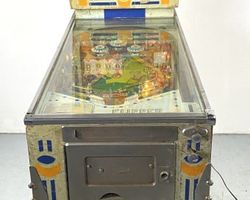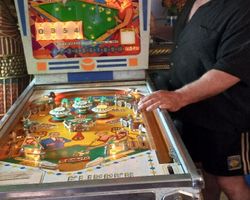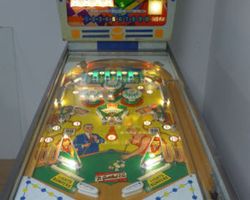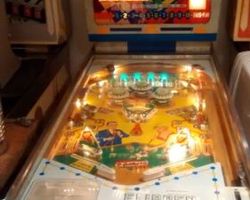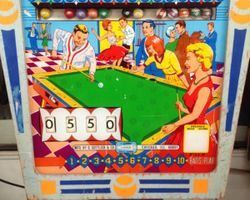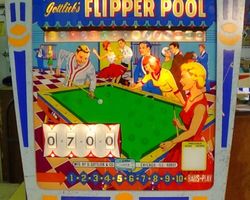Flipper Pool
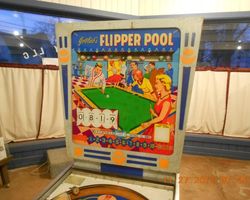
Average Prices: USD $400 to $700
Produced: October, 1965
Production Run: 700 units
Machine Type: Electro-mechanical
Players: 1
Design by: Ed Krynski
Art by: Roy Parker
Gottlieb's "Flipper Pool," released in October 1965, emerged as a distinct electro-mechanical (EM) pinball machine, drawing inspiration from the precise game of 14.1 continuous pool, also known as straight pool. D. Gottlieb & Co., a prominent name in the pinball industry, introduced this single-player machine with a production run of 700 units, solidifying its place in the era's competitive market. The creative team behind "Flipper Pool" was a synergy of talent, with Ed Krynski taking the lead on design, mechanics, and the intricate backbox animation. Roy Parker, a prolific artist for Gottlieb, masterfully brought the billiards theme to life through the machine's visuals. The core concept for the game was a collaborative effort involving Alvin Gottlieb, Ed Krynski, and Wayne Neyens, aiming to translate the strategic depth of pool into an interactive pinball experience. This machine was particularly notable for its "Add-A-Ball" specialty, a feature that allowed players to extend their game by earning additional balls, diverging from the more common replay-centric machines of the time. This focus on extended play rather than free games was a design choice that offered a different kind of engagement for players. The replay version of "Flipper Pool" was "Bank-A-Ball," released in the same year, while an Italian model was known as "Electra-Pool." These variations underscore the machine's appeal and Gottlieb's strategy to cater to different market preferences with a similar playfield design but distinct scoring and game-end mechanics.
Signature Features and Design
"Flipper Pool" distinguishes itself through a unique and highly engaging mechanical animation housed within its backbox. This feature is the heart of the machine's thematic integration and visual appeal. At the start of a game, an illuminated billiard table graphic in the backglass shows all fifteen balls lit, and corresponding mechanical balls above the table are hidden from view. As players hit specific numbered targets on the playfield, the lit ball on the backglass graphic corresponding to that target turns off, and a mechanical ball physically drops into view above the table, simulating a "sunk" ball. This dynamic visual feedback directly reinforces the pool theme, transforming abstract score accumulation into a tangible representation of clearing the billiard table. This animation is a standout element, enhancing player immersion and providing a clear, satisfying progression throughout the game. Beyond its mechanical innovation, the machine benefits from Roy Parker's artistic touch. The playfield and backglass artwork are rendered with vibrant colors and thematic elements that evoke the atmosphere of a classic billiard hall, featuring billiard balls, cues, and green table felt. The cabinet, often presented in a distinctive blue, further contributes to its visual identity, making it a recognizable and aesthetically pleasing machine from its era.
Playfield and Mechanics
The playfield of "Flipper Pool" is a meticulously designed arena for its billiards-inspired gameplay. It features a straightforward yet challenging layout, anchored by two flippers positioned at the bottom of the playfield. Above the flippers, two slingshots provide reactive deflection for the ball, propelling it back into the upper playfield. Three pop bumpers are strategically placed to introduce chaotic bounces and scoring opportunities, keeping the ball in motion and demanding player alertness. The primary objectives are a series of seven standup targets, each typically numbered or arranged to represent the billiard balls. The design philosophy behind this layout is to replicate the progression of a straight pool game, where players aim to "sink" all fifteen balls. While there are only seven physical targets, hitting them in sequence or repeatedly contributes to the "sinking" of the full rack of fifteen balls represented in the backbox animation. The layout encourages precise shots to these targets, requiring players to control the ball effectively and aim deliberately. Missing a crucial shot or hitting a metal post near the center target can result in a quick drain, adding a layer of risk and reward to each shot. The playfield artwork seamlessly integrates with the theme, featuring representations of billiard balls, racks, and a felt-like green background. This, combined with the machine's lighting, which highlights active targets and scoring areas, guides the player's focus and contributes to the overall immersive experience, making the act of hitting targets feel like a deliberate shot in a game of pool.
Gameplay Dynamics
The gameplay of "Flipper Pool" is centered around its "Add-A-Ball" mechanic and the thematic pursuit of clearing the pool table. The core objective is to hit the numbered standup targets on the playfield. Each successful hit corresponds to "sinking" a billiard ball, which is visually confirmed by the mechanical animation in the backbox, where a physical ball drops into view and its corresponding light on the backglass turns off. Players accumulate points for hitting targets and engaging pop bumpers, with the maximum displayed score reaching 9,999 points. The progression culminates when all fifteen "balls" are sunk, as indicated by the backbox animation. Upon "clearing the rack," the mechanical balls in the backbox reset, returning to their hidden positions, and all lights on the backglass billiard table illuminate once more, ready for the next "rack." Crucially, clearing a rack often awards an additional ball, hence the "Add-A-Ball" designation. This feature significantly extends gameplay, rewarding skilled players with the opportunity to continue playing beyond the initial ball count. The strategic depth comes from the need for accuracy and ball control to consistently hit the targets while managing the risk of draining the ball. While there are no distinct "modes" in the contemporary sense, the game's progression emulates the rhythm of a billiards match, with players striving for successive "racks." For experienced players, the challenge lies in setting the machine's internal pins to require a higher number of "balls" (e.g., 14 or 15) to earn an extra ball, thereby increasing the difficulty and demanding sustained precision. The rewarding sound of three distinct bells and a knocker further enhances the experience, providing satisfying audio feedback for key achievements and milestones within the game.
Reception and Legacy
"Flipper Pool" has garnered a largely positive reception among pinball enthusiasts and collectors, often described as an exciting, challenging, and enjoyable electro-mechanical game. Its standout qualities often lead to it being considered a "keeper" for those who appreciate the era's machines. A significant strength frequently highlighted is the successful integration of its pool theme, enhanced by Roy Parker's artwork, which is consistently praised for its vibrancy and thematic appropriateness. The machine's aesthetic, including its distinctive blue cabinet, is often noted as a positive contributor to its visual appeal. The "Add-A-Ball" feature is widely regarded as a major draw, providing a substantial increase in fun and excitement. This mechanism can lead to extended gameplay sessions, offering rewarding experiences that differentiate it from machines focused purely on replays. The gameplay itself is celebrated for being easy to grasp yet challenging to master, demanding precise shots and offering high replayability. The mechanical animated pool balls in the backglass animation are a defining characteristic, frequently cited as a superb visual element that elevates the game. Many in the pinball community consider "Flipper Pool" to offer a more engaging and distinct gameplay experience compared to its replay counterpart, "Bank-A-Ball," drawing parallels to the strategic nature of "14.1" continuous pool. The automatic re-racking of balls in the backglass animation after clearing a set is also a well-received, thematic mechanic that adds to the game's appeal. Even novice players find the game accessible and quickly grasp its objectives, fostering a desire for continued play.
However, "Flipper Pool" is not without its points of discussion. Some players have noted the existence of a "dead shot" where the ball might circle without hitting targets or pop bumpers, potentially leading to frustration. The design also presents a risk of ball drain if a shot misses the center target and hits a metal post directly. A more common practical concern revolves around the fragility of the backglass pool balls, which can be prone to breakage or loss, and can be costly to replace due to their custom nature. From a gameplay perspective, some suggest that the "Add-A-Ball" feature can make the game too easy if the starting number of balls required to earn an extra ball is set too low. Adjusting the machine's internal settings to require hitting 14 or 15 balls to award an extra ball is a common recommendation to increase the challenge for more experienced players. Despite these considerations, "Flipper Pool" maintains a strong legacy as a premier Gottlieb EM title. Its innovative mechanical backbox animation influenced later designs seeking to integrate thematic visual progression directly into gameplay. The machine stands as a testament to the creativity and mechanical ingenuity prevalent in pinball during the mid-1960s, securing its place as a memorable and sought-after game for its distinctive play and compelling presentation.
Sponsored Links
 Ebay Listings
Ebay Listings
 Auction Results
Auction Results
| Cost | Location | Date |
|---|---|---|
| USD $400 |  Connecticut, United States Connecticut, United States |
28 April, 2025 |
| USD $595 |  Minnesota, United States Minnesota, United States |
24 May, 2023 |
| USD $461 |  Wisconsin, United States Wisconsin, United States |
01 April, 2019 |
| USD $1,200 |  Arizona, United States Arizona, United States |
28 November, 2018 |
| USD $425 |  Wisconsin, United States Wisconsin, United States |
01 September, 2018 |
| USD $421 |  Wisconsin, United States Wisconsin, United States |
25 August, 2018 |
| USD $607 |  Wisconsin, United States Wisconsin, United States |
06 November, 2017 |
| AUD $1,725 |  Australia Australia |
22 May, 2016 |
| USD $710 |  Washington, United States Washington, United States |
21 March, 2016 |
| USD $725 |  New York, United States New York, United States |
13 January, 2016 |


Private Policy · Search Website · Contact Us
As an eBay Partner, we may earn a commission from qualifying purchases made through links on this site, at no additional cost to you.
All trademarks and copyrighted materials remain property of their respective owners. All other content copyright 2007 - 2025 Pinpedia.

